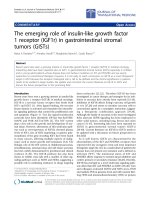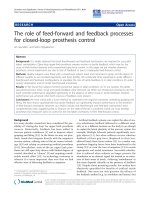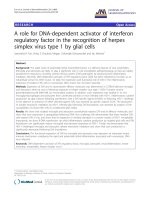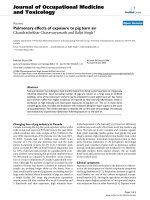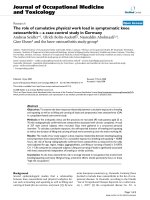Báo cáo hóa học: " The role of single N-glycans in proteolytic processing and cell surface transport of the Lassa virus glycoprotein GP-C" ppt
Bạn đang xem bản rút gọn của tài liệu. Xem và tải ngay bản đầy đủ của tài liệu tại đây (679.16 KB, 7 trang )
BioMed Central
Page 1 of 7
(page number not for citation purposes)
Virology Journal
Open Access
Research
The role of single N-glycans in proteolytic processing and cell
surface transport of the Lassa virus glycoprotein GP-C
Robert Eichler
1,2
, Oliver Lenz
1,3
, Wolfgang Garten*
1
and Thomas Strecker
1
Address:
1
Institut für Virologie der Philipps-Universität Marburg, Hans-Meerwein-Str. 3, 35037 Marburg, Germany,
2
Abbott GmbH & Co KG, Max-
Planck-Ring 2, 65205 Wiesbaden, Germany and
3
Tibotec BVBA, Gen De Wittelaan L 11B 3, 2800 Mechelen, Belgium
Email: Robert Eichler - ; Oliver Lenz - ; Wolfgang Garten* - ;
Thomas Strecker -
* Corresponding author
Abstract
Lassa virus glycoprotein is synthesised as a precursor (preGP-C) into the lumen of the endoplasmic
reticulum. After cotranslational cleavage of the signal peptide, the immature GP-C is
posttranslationally processed into the N-terminal subunit GP-1 and the C-terminal subunit GP-2
by the host cell subtilase SKI-1/S1P. The glycoprotein precursor contains eleven potential N-
glycosylation sites. In this report, we investigated the effect of each N-glycan on proteolytic
cleavage and cell surface transport by disrupting the consensus sequences of eleven potential N-
glycan attachment sites individually. Five glycoprotein mutants with disrupted N-glycosylation sites
were still proteolytically processed, whereas the remaining N-glycosylation sites are necessary for
GP-C cleavage. Despite the lack of proteolytic processing, all cleavage-defective mutants were
transported to the cell surface and remained completely endo H-sensitive. The findings indicate
that N-glycans are needed for correct conformation of GP-C in order to be cleaved by SKI-1/S1P.
Background
Lassa virus belongs to the family of Arenaviridae which
includes other important human pathogens like Machupo
virus, Junin virus, Guanarito virus and Sabia virus as well
as the prototype of this family, Lymphocytic Choriomen-
ingitis virus (LCMV). Lassa virus is endemic in certain
parts of West Africa and causes an estimated 150 000 clin-
ical cases of a systemic viral illness per year, with a mortal-
ity rate of 10–15% [1]. Lassa fever is not only a public
health concern in endemic areas, it is also sporadically
exported to other parts of the world [2].
Lassa virus is an enveloped virus with a bi-segmented RNA
genome which encodes four viral proteins in an ambi-
sense coding strategy: the glycoprotein precursor preGP-
C, a nucleoprotein (NP), the viral polymerase L and the
matrix protein Z (for review see [3]). The Lassa virus glyc-
oprotein is translated as an inactive precursor (pre-GP-C)
into the lumen of the endoplasmic reticulum and is then
cotranslationally cleaved into GP-C and a stable signal
peptide [4]. The latter one plays an important role in the
subsequent posttranslational maturation cleavage of GP-
C into its subunits GP1 and GP2 [5,6]. Lassa virus GP-C is
cleaved at the C-terminus of a non-basic amino acid resi-
due of the cleavage motif R-R-L-L by the subtilase SKI-1/
S1P, which is unusual for fusiogenic glycoproteins of
enveloped viruses [7]. So far, only viral glycoproteins of
the arenavirus family and the glycoprotein of the
Crimean-Congo hemorrhagic fever virus belonging to the
family of Bunyaviridae are known to be cleaved by SKI-1/
S1P, an enzyme that normally plays a role in regulation of
the lipid metabolism of the cell [6,8-10]. Fusiogenic glyc-
Published: 31 May 2006
Virology Journal 2006, 3:41 doi:10.1186/1743-422X-3-41
Received: 01 February 2006
Accepted: 31 May 2006
This article is available from: />© 2006 Eichler et al; licensee BioMed Central Ltd.
This is an Open Access article distributed under the terms of the Creative Commons Attribution License ( />),
which permits unrestricted use, distribution, and reproduction in any medium, provided the original work is properly cited.
Virology Journal 2006, 3:41 />Page 2 of 7
(page number not for citation purposes)
oproteins of most other enveloped viruses are proteolyti-
cally cleaved C-terminally of a single arginine residue or at
a multibasic recognition motif by the subtilase furin [11].
N-glycans play not only an important role in folding and
intracellular transport of viral glycoproteins but also are
known to modulate their antigenicity and activity [12-21].
Glycoproteins of arenaviruses vary considerably in
number and position of potential N-glycosylation sites as
shown by an N-glycosylation prediction program (Table
1). The Lassa virus glycoprotein GP-C contains eleven
potential N-glycosylation consensus sites (N-X-S/T, in
which X can be any amino acid except proline), where
seven of these are located in the GP1- and four in the GP2-
subunit (Table 1). Using limited N-Glycanase digestion,
Wright et al. [22] demonstrated for LCMV GP that five
potential glycosylation sites on GP-1 were utilized and
two of the three sites on GP-2. However, for Lassa virus GP
it has not yet been shown which sites are actually used and
how N-glycosylation affects the characteristics of the glyc-
oprotein in respect to cleavage and transport along the
exocytotic pathway. To address this question, we investi-
gated in the present report each potential N-glycosylation
site of the Lassa virus glycoprotein concerning N-glycan
maturation, cleavage of GP-C and glycoprotein transport
to the cell surface. We provide evidence that each of the 11
N-glycosylation sites is used for N-glycan attachment.
However, seven N-glycan mutants failed in their ability to
get proteolytically processed, while 4 N-glycosylation sites
are individually dispensable for cleavage of GP-C. Further-
more, we demonstrate that both uncleaved precursor and
cleavage-defective N-glycan mutants are transported to
the cell surface and remain mannose-rich.
Materials and methods
Cell culture
Vero cells were cultured in Dulbecco's Modified Eagle's
Medium (DMEM, GIBCO) supplemented with 10% fetal
calf serum (FCS), 100 units/ml penicillin, and 0.1 mg/ml
streptomycin.
Antibodies
Oligopeptide comprising the amino acids 477–491 of
preGP-C was chemically synthesized and covalently
linked to keyhole limpet hemocyanin (KLH, Pierce) as a
carrier protein by the cross-linker agent N- [α-maleimi-
doacetoxy] succinimide ester (AMAS) and used for
repeated immunization of rabbits as described before [7].
The obtained antiserum Rb-α-GP2 was tested by peptide
standard ELISA [18] and used for immunoblot analyses.
Mutation and vectorial expression of recombinant Lassa
virus glycoprotein
The full length glycoprotein of Lassa virus (strain Josiah)
was expressed using the beta-actin promotor-driven
pCAGGS vector [6,23]. Lassa virus N-glycosylation
mutants were generated by recombinant PCR using over-
lapping oligonucleotides, which will be made available
on request. Sequences of mutants were confirmed by DNA
sequencing. Vero cells were transfected with wild type and
mutated recombinant DNA using Lipofectamine 2000
(Gibco/Invitrogen).
Table 1: Comparison of potential N-glycosylation sites between different Arenavirus glycoproteins. Numbers indicate amino acid (aa)
position of serine/threonine of potential N-glycosylation sites in Arenavirus glycoproteins. Gene bank accession numbers for viral
sequences: Lassa-Josiah (J04324
), LCMV-Arm (P09991), Mopeia (M33879), Tacaribe (NC_004293), White Water Arroyo (AF228063),
Guanarito (AY129247
), Sabia (U41071), Junin (D10072), Machupo (AY129248), Pichinde (AF081554).
Potential N-glycosylation sites in Arenavirus glycoproteins
GP-1 GP-2
Virus N GP-1 N GP-2 N GP-C aa
length
GP-C
Lassa - - - 81 91 101 111 - - 121 - - 169 - - 226 7 -367375392397 411491
LCMV - - - 87 97 - 116 - - 126 - - 173 - - 234 6 -373-398403 39498
Mopeia - - - 80 90 100 110 - - 120 - - 168 - - 224 7 -365373390395 411489
Machupo - - - 85 97 - - - - 139 168 - 180 - - - 5 -370378395400 49496
Tacaribe - - - 85 97 - - - - - 166 - 178 - - - 4 -357365382387 48483
Sabia - 71 - - 90 101 - - 127 - - 173 180 - - 224 7 -362370387392 411488
Guanarito 90- 127 - - -176204-216 5 316 353 361 378 383 49479
Junin 97107 - - - -180- - - 3 -359367384389 47495
Whitewater - - 75 - 90 - - - 128 - 167 - 178 - - 217 6 317 354 362 379 384 511480
Pichinde 69 76 - 91 102 113 118 123 134 - - - 183 - 219 243 11 -381389406411 415508
Virology Journal 2006, 3:41 />Page 3 of 7
(page number not for citation purposes)
Cell surface biotinylation assay, immunoprecipitation and
treatment with glycosidases
Wild type glycoprotein of Lassa virus or N-glycosylation
mutants were expressed in Vero cells. At 24 h post-trans-
fection, cells were washed three times with cold phos-
phate-buffered saline (PBS) and then cell surface was
incubated twice for 15 min at 4°C with 2 mg/ml sulfo-N-
hydroxysuccinimidobiotin (Pierce) by adding 1 ml of the
biotinylating reagent. After biotinylation, cells were
washed twice with cold PBS containing 0.1 M glycine and
three times with PBS. Cells were lysed in 0.5 ml RIPA (1%
Triton X-100, 1% sodium deoxycholate, 0.1% SDS, 0.15
M NaCl, 10 mM EDTA, 10 mM iodacetamide, 1 mM phe-
nylmethylsulfonyl fluoride, 50 units/ml aprotinin, and 20
mM Tris-HCl), followed by centrifugation for 30 min at
20 000 g. The supernatant was immunoprecipitated with
anti-GP-C at a final dilution of 1:1000. After addition of
30 µl protein A-Sepharose CL-4B (Sigma), immunocom-
plexes were washed three times with RIPA. Then samples
were treated with either endo-β-N-acetylglucosaminidase
H (endo H; New England Biolabs) or N-glycosidase F
(PNGase F; New England Biolabs) according to the
instructions of the manufacturer, or left untreated. Sam-
ples were resuspended in reducing sample buffer for SDS-
polyacrylamide gel electrophoresis (PAGE), followed by
separation on a 12% polyacrylamide gel, before proteins
were blotted to nitrocellulose. Biotinylated cell surface
proteins were detected by incubation with a streptavidin-
biotinylated horseradish peroxidase complex (Amersham
Pharmacia Biotech) diluted 1:2000 in PBS. Proteins were
visualized with the enhanced chemiluminescence system
(Amersham Pharmacia Biotech) by exposure to an autora-
diography film (Kodak BIOMAX).
Results and discussion
Mutation of potential N-glycosylation sites of Lassa virus
preGP-C
Lassa virus preGP-C contains 11 potential N-glycosylation
sites, 7 in the GP-1- and 4 in the GP-2-subunit (Fig. 1). To
investigate whether each N-glycosylation site is used for
N-glycan attachment, the corresponding serine or threo-
nine residues of potential N-glycosylation motifs (N-X-S/
T) were individually changed to alanine. GP-1 mutants
were designated T81A, S91A, T101A, S111A, S121A,
S169A and T226A and GP-2 mutants S367A, S375A,
S392A and S397A. All cDNA constructs were expressed
transiently in Vero cells using the beta-actin promoter-
driven mammalian expression vector pCAGGS. Western
blotting was performed using antiserum directed against
the C-terminus of GP-2. As shown in Fig. 2A (lanes 2–8,
upper panel) and Fig. 2B (lanes 2–5, upper panel), all
mutants showed faster migration on a SDS gel compared
to wild-type GP-C indicating that each N-glycosylation
site is used for N-glycan attachment. Next we determined
the effect of the individual N-glycans on the maturation
cleavage by analysing the presence of the cleaved subunit
GP-2. Disruption of the N-glycosylation sites within the
GP-1 mutants S111A, S169A and T226A has no influence
on GP-C cleavage (Fig. 2A, lanes 5, 7 and 8, lower panel).
In contrast, the lack of N-glycan attachment of the GP-1
mutants T81A, S91A, S101A and S121A abolished the
proteolytical processing by SKI-1/S1P (Fig. 2A, lanes 2–4
and 6, lower panel). Among the four N-glycosylation sites
of GP-2, only GP-C of the mutants S392A and S397A are
further cleaved into GP-1 and GP-2 similar to fully glyco-
sylated wild-type GP-C (Fig. 2B, lanes 4 and 5, lower
panel), whereas no cleavage of the glycoprotein was
observed within the mutants S367A and S375A (Fig. 2B,
lanes 2 and 3, lower panel). Due to the high resolution of
the acrylamid gel electrophoresis, the GP-2 subunit of
Schematic diagram of Lassa virus glycoproteinFigure 1
Schematic diagram of Lassa virus glycoprotein. The primary translation product preGP-C (aa 1–491), the signal peptide
(SP) (aa 1–58), the precursor glycoprotein GP-C (aa 59–491) and the subunits GP-1 (aa 59–259) and GP-2 (260–491) are
shown. Hydrophobic regions are indicated in stripes. The signal peptidase (SPase) cleavage site between threonine residues 58
and 59 (arrow), the SKI-1/S1P cleavage site C-terminally of leucine 259 (arrow) and the rabbit antiserum binding site, α-GP2
(aa 477–491) are indicated. Eleven potential N-glycosylation sites (tree-like symbols) were identified. Amino acid positions of
potential N-glycosylation sites are shown.
Virology Journal 2006, 3:41 />Page 4 of 7
(page number not for citation purposes)
mutants S392A and S397A revealed significantly faster
electrophoretic mobility than wild type GP-2 (Fig. 2B;
lanes 4–5, lower panel) showing that the respective N-gly-
cosylation sites are used for N-glycan attachment.
Cell surface transport of GP N-glycosylation mutants
N-glycosylation has long been known to be essential for
correct folding and intracellular transport of viral glyco-
proteins, as shown for instances for influenza hemagglu-
tinin [19]. In order to investigate the importance of the
individual N-glycosylation sites of Lassa virus GP-C for
intracellular trafficking we analysed cell surface expres-
sion of the mutated glycoproteins using a biotinylation
approach. Transfected Vero cells were labelled with non-
membrane-permeating biotin as described in material
and methods. After biotinylation, cells were lysed and GP-
Proteolytic processing of N-glycosylation mutantsFigure 2
Proteolytic processing of N-glycosylation mutants. A Vero cells expressing either wild-type GP-C or GP-1 N-glycosylation
mutants T81A, S91A, T101A, S111A, S121A, S169A and T226A. B Vero cells expressing either wild-type GP-C or GP-2 N-gly-
cosylation mutants S367A, S375A, S392A and S397A. The expressed proteins were separated by SDS-PAGE on 12% acryla-
mide gels and immunoblotted. Non-cleaved GP-C and its cleaved form GP-2 are detected by immunostaining using the
antiserum rb-α-GP-2.
Virology Journal 2006, 3:41 />Page 5 of 7
(page number not for citation purposes)
C and GP-C N-glycan mutants were immunoprecipitated
using polyclonal antiserum directed against the C-termi-
nus of GP-C. The precipitates were separated on an SDS
gel and transferred to nitrocellulose. Surface-expressed
glycoprotein protein was then visualised with a streptavi-
din-peroxidase complex. Fig. 3A (lanes 2–8) and B (lanes
2–5) demonstrate that all GP-1 and GP-2 N-glycosylation
mutants are transported to the cell surface in a similar
manner compared to wild-type GP indicating that a loss
of a single N-glycosylation attachment site and proteolytic
cleavage are not necessary for cell surface transport of GP.
For LCMV it was shown that maturation cleavage deficient
mutants are efficiently transported to the cell surface [10].
Both cleavage and cell surface expression of LCMV GP-C
are impaired in parallel either when no N-glycosylation
occurs or a proline residue is present at position 110
[22,24]. Since many cleavage deficient mutants have been
shown to exhibit regular cell surface transport, the two
reported cases in which cell surface expression was abol-
ished might be due to misfolding in the endoplasmic
reticulum with subsequent degradation [22,24].
Cell surface transport of GP-C N-glycosylation mutantsFigure 3
Cell surface transport of GP-C N-glycosylation mutants. Vero cells were transfected with GP-1 (A) and GP-2 (B) N-glyc-
osylation mutants of Lassa virus glycoprotein. At 24 h post-transfection, cells were surface labelled with biotin. Following cell
lysis and immunoprecipitation using α-GP-2, samples were subjected to SDS-PAGE and blotted to nitrocellulose. Surface
biotin-labelled proteins were visualized with streptavidin-peroxidase and chemiluminescence.
Virology Journal 2006, 3:41 />Page 6 of 7
(page number not for citation purposes)
Transport of endo H-sensitive GP-C to the cell surface
LCMV and Lassa virus GP-C are cleaved by the same pro-
tease, SKI-1/S1P, although proteolytic processing of the
GPs occurs in different subcellular compartments. Lassa
virus GP-C is cleaved early along the secretory pathway in
the ER or an early Golgi stack, whereas LCMV GP-C is
cleaved in the Golgi or post-Golgi compartment
[6,10,22]. Furthermore, for LCMV GP-C it has been
shown that transition of mannose-rich carbohydrates to
complex carbohydrates occurred before maturation cleav-
age [22]. In order to analyse the glycosylation status of
Lassa virus glycoproteins on the outer cell membrane, cell
surface biotinylation was combined with a subsequent
detachment of mannose-rich N-glycans by digestion with
endo H or removal of complex N-glycans using PNGase F
(Fig. 4). The GP-2 subunit is detectable at the cell surface
and displays partial endo H-resistance confirming a mod-
ification of its carbohydrate decoration during glycopro-
tein transport to the cell surface (lane 2). Interestingly, the
glycoprotein precursor GP-C which is transported to the
cell surface remains completely endo H-sensitive suggest-
ing that cleavage might be a prerequisite for further com-
plex glycosylation. In addition, uncleaved endo H-
sensitive Lassa virus GP-C is also transported to the cell
surface of SKI-1/S1P deficient cells (data not shown).
The finding that only an endo H-sensitive form of Lassa
virus GP-C was found at the cell surface suggests that par-
tial endo H-resistance of the Lassa virus glycoprotein is
only acquired when the glycoprotein is cleaved into its
subunits. This observation is in contrast to findings for the
LCMV glycoprotein where an endo H-resistant form of
GP-C was described [22]. However, since cleavage of Lassa
virus GP-C by SKI-1/S1P occurs earlier in the exocytotic
pathway than LCMV GP-C [6,10,22], cleavage of Lassa
virus GP-C occurs prior to trimming of the mannose-rich
N-glycans to complex sugar types.
It can not be ruled out that the use of glycosylation sites
and the N-glycan trimming differs between recombinant
expressed glycoproteins and GP in LASV-infected cells. It
was shown recently that recombinant expressed M protein
of SARS-CoV gained complex-type N-glycosylation
whereas in SARS-CoV infected cells N-glycosylation of M
remained endo H-sensitive [25]. However, in general a
good correlation between results obtained after solitary
expression and studies using the homologues viral system
have been observed. To address this kind of issues, the
development of a "reverse genetic system" for LASV will
be necessary that would allow analysing the role of glyco-
sylation of GP in the correct viral context.
Conclusion
Taken together, our study suggest that individual N-linked
oligosaccharides of the Lassa virus glycoprotein differ
greatly in terms of their importance for correct protein
folding which seems to be important for activation cleav-
age by SKI-1/S1P. The differences between the precursor
glycoprotein GP-C and the cleaved subunits GP-1 and GP-
2, not only with respect to N-glycosylation, remain an
enigma since only the cleaved glycoprotein subunits are
incorporated into virus particles [6].
Abbreviations
aa; amino acid; DMEM, Dulbecco's Modified Eagle's
Medium; GP, glycoprotein, PCR, polymerase chain reac-
tion; Endo H, endoglycosidase H; PNGase F, peptide-N-
glycosidase F; RIPA, radio immunoprecipitation assay;
SKI-1/S1P, subtilisin kexin isoenzyme-1/site 1 protease;
SDS-PAGE, sodium dodecyl sulfate-polyacrylamide gel
electrophoresis; Tris, tris-(hydroxymethyl)-ami-
nomethan.
Glycosidase sensitivity of cell surface transported Lassa virus glycoproteinFigure 4
Glycosidase sensitivity of cell surface transported Lassa
virus glycoprotein. At 48 h post-transfection, Vero cells
expressing wild-type Lassa virus glycoprotein were surface
biotinylated and immunoprecipitated as described under Fig.
3. Precipitated samples were either left untreated (lane 1),
digested with Endo H (lane 2) or PNGase F (lane 3). The
samples were separated by SDS-PAGE with subsequent
immunoblotting. Biotinylated proteins were detected using
streptavidin coupled to horse radish peroxidase and chemilu-
minescence.
Publish with BioMed Central and every
scientist can read your work free of charge
"BioMed Central will be the most significant development for
disseminating the results of biomedical research in our lifetime."
Sir Paul Nurse, Cancer Research UK
Your research papers will be:
available free of charge to the entire biomedical community
peer reviewed and published immediately upon acceptance
cited in PubMed and archived on PubMed Central
yours — you keep the copyright
Submit your manuscript here:
/>BioMedcentral
Virology Journal 2006, 3:41 />Page 7 of 7
(page number not for citation purposes)
Competing interests
The author(s) declare that they have no competing inter-
ests.
Authors' contributions
RE and TS carried out experiments, participated in the
analysis of the results and drafted the manuscript. OL
helped to draft the manuscript and revised it critically.
WG designed the study, participated in the analysis of the
results and helped to draft the manuscript. All authors
read and approved the final manuscript.
Acknowledgements
We thank E. Lecompte, M. Eickmann and H D. Klenk for helpful discus-
sions and P. Neubauer-Rädel for excellent technical assistance. This work
was supported by the Deutsche Forschungsgemeinschaft, Sachbeihilfe Ga
282/4-1, SFB 286 TP1, and the Graduiertenkolleg Protein Function at the
Atomic Level.
References
1. McCormick JB, Fisher-Hoch SP: Lassa fever. Curr Top Microbiol
Immunol 2002, 262:75-109.
2. Gunther S, Emmerich P, Laue T, Kuhle O, Asper M, Jung A, Grewing
T, ter Meulen J, Schmitz H: Imported lassa fever in Germany:
molecular characterization of a new lassa virus strain. Emerg
Infect Dis 2000, 6(5):466-476.
3. Gunther S, Lenz O: Lassa virus. Crit Rev Clin Lab Sci 2004,
41(4):339-390.
4. Eichler R, Lenz O, Strecker T, Garten W: Signal peptide of Lassa
virus glycoprotein GP-C exhibits an unusual length. FEBS Lett
2003, 538(1-3):203-206.
5. Eichler R, Lenz O, Strecker T, Eickmann M, Klenk HD, Garten W:
Identification of Lassa virus glycoprotein signal peptide as a
trans-acting maturation factor. EMBO Rep 2003,
4(11):1084-1088.
6. Lenz O, ter Meulen J, Klenk HD, Seidah NG, Garten W: The Lassa
virus glycoprotein precursor GP-C is proteolytically proc-
essed by subtilase SKI-1/S1P. Proc Natl Acad Sci U S A 2001,
98(22):12701-12705.
7. Lenz O, ter Meulen J, Feldmann H, Klenk HD, Garten W: Identifica-
tion of a novel consensus sequence at the cleavage site of the
Lassa virus glycoprotein. J Virol 2000, 74(23):11418-11421.
8. Sanchez AJ, Vincent MJ, Nichol ST: Characterization of the glyc-
oproteins of Crimean-Congo hemorrhagic fever virus. J Virol
2002, 76(14):7263-7275.
9. Vincent MJ, Sanchez AJ, Erickson BR, Basak A, Chretien M, Seidah
NG, Nichol ST: Crimean-Congo hemorrhagic fever virus glyc-
oprotein proteolytic processing by subtilase SKI-1. J Virol
2003, 77(16):8640-8649.
10. Beyer WR, Popplau D, Garten W, von Laer D, Lenz O: Endoprote-
olytic processing of the lymphocytic choriomeningitis virus
glycoprotein by the subtilase SKI-1/S1P. J Virol 2003,
77(5):2866-2872.
11. Klenk HD, Garten W: Host cell proteases controlling virus
pathogenicity. Trends Microbiol 1994, 2(2):39-43.
12. Bagai S, Lamb RA: Individual roles of N-linked oligosaccharide
chains in intracellular transport of the paramyxovirus SV5
fusion protein. Virology 1995, 209(1):250-256.
13. Doms RW, Lamb RA, Rose JK, Helenius A: Folding and assembly
of viral membrane proteins. Virology 1993, 193(2):545-562.
14. Hu A, Cathomen T, Cattaneo R, Norrby E: Influence of N-linked
oligosaccharide chains on the processing, cell surface expres-
sion and function of the measles virus fusion protein. J Gen
Virol 1995, 76 ( Pt 3):705-710.
15. Klenk HD, Wagner R, Heuer D, Wolff T: Importance of hemag-
glutinin glycosylation for the biological functions of influenza
virus. Virus Res 2002, 82(1-2):73-75.
16. Koch M, Pancera M, Kwong PD, Kolchinsky P, Grundner C, Wang L,
Hendrickson WA, Sodroski J, Wyatt R: Structure-based, targeted
deglycosylation of HIV-1 gp120 and effects on neutralization
sensitivity and antibody recognition. Virology 2003,
313(2):387-400.
17. Moll M, Kaufmann A, Maisner A: Influence of N-glycans on
processing and biological activity of the nipah virus fusion
protein. J Virol 2004, 78(13):7274-7278.
18. Munk K, Pritzer E, Kretzschmar E, Gutte B, Garten W, Klenk HD:
Carbohydrate masking of an antigenic epitope of influenza
virus haemagglutinin independent of oligosaccharide size.
Glycobiology 1992, 2(3):233-240.
19. Roberts PC, Garten W, Klenk HD: Role of conserved glycosyla-
tion sites in maturation and transport of influenza A virus
hemagglutinin. J Virol 1993, 67(6):3048-3060.
20. Segawa H, Yamashita T, Kawakita M, Taira H: Functional analysis
of the individual oligosaccharide chains of sendai virus fusion
protein. J Biochem (Tokyo) 2000, 128(1):65-72.
21. Wagner R, Heuer D, Wolff T, Herwig A, Klenk HD: N-Glycans
attached to the stem domain of haemagglutinin efficiently
regulate influenza A virus replication. J Gen Virol 2002, 83(Pt
3):601-609.
22. Wright KE, Spiro RC, Burns JW, Buchmeier MJ: Post-translational
processing of the glycoproteins of lymphocytic choriomenin-
gitis virus. Virology 1990, 177(1):175-183.
23. Niwa H, Yamamura K, Miyazaki J: Efficient selection for high-
expression transfectants with a novel eukaryotic vector.
Gene 1991, 108(2):193-199.
24. Beyer WR, Miletic H, Ostertag W, von Laer D: Recombinant
expression of lymphocytic choriomeningitis virus strain WE
glycoproteins: a single amino acid makes the difference. J
Virol 2001, 75(2):1061-1064.
25. Voss D, Kern A, Traggiai E, Eickmann M, Stadler K, Lanzavecchia A,
Becker S: Characterization of severe acute respiratory syn-
drome coronavirus membrane protein. FEBS Lett 2006,
580(3):968-973.





